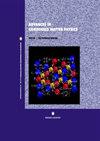First-Principles Study on Adsorption and Decomposition of NOx on Mo (110) Surface
IF 1.8
4区 物理与天体物理
Q3 PHYSICS, CONDENSED MATTER
引用次数: 0
Abstract
Based on the density functional theory, the adsorption and decomposition of NOx (x = 1, 2) on Mo (110) surface are studied with first-principles calculations. Results show that the stable structures of NO2/Mo (110) are MoNO2 (T, μ1-N), MoNO2 (H, μ3-N, O, O′), MoNO2 (S, η2-O, O′), and MoNO2 (L, η2-O, O′). The corresponding adsorption energies for the structures are −3.83 eV, −3.40 eV, −2.81 eV, and −2.60 eV, respectively. Besides, the stable structures of NO/Mo (110) are MoNO (H, μ1-N), MoNO (H, μ2-N, O), and MoNO (H, η1-N) with the corresponding adsorption energies of −3.75 eV, −3.57 eV, and −3.01 eV, respectively. N and O atoms are easily adsorbed at the hollow sites on Mo (110) surfaces, and their adsorption energies reach −7.02 eV and −7.70 eV, respectively. The preferable decomposition process of MoNO2 (H, μ3-N, O, O′) shows that the first and second deoxidation processes need to overcome energy barriers of 0.11 eV and 0.64 eV, respectively. All these findings indicate that NO2 is relatively easy to dissociate on Mo (110) surface.Mo(110)表面吸附和分解NOx的第一性原理研究
基于密度泛函理论,用第一性原理计算研究了NOx (x = 1,2)在Mo(110)表面的吸附和分解。结果表明,NO2/Mo(110)的稳定结构为MoNO2 (T, μ1-N)、MoNO2 (H, μ3-N, O, O’)、MoNO2 (S, η2-O, O’)和MoNO2 (L, η2-O, O’)。相应的吸附能分别为−3.83 eV,−3.40 eV,−2.81 eV和−2.60 eV。NO/Mo(110)的稳定结构为MoNO (H, μ1-N)、MoNO (H, μ2-N, O)和MoNO (H, η - n),对应的吸附能分别为- 3.75 eV、- 3.57 eV和- 3.01 eV。N和O原子在Mo(110)表面的空穴位置易于吸附,其吸附能分别达到- 7.02 eV和- 7.70 eV。MoNO2 (H, μ3-N, O, O’)的较优分解过程表明,第一次和第二次脱氧过程分别需要克服0.11 eV和0.64 eV的能垒。这些结果表明NO2在Mo(110)表面相对容易解离。
本文章由计算机程序翻译,如有差异,请以英文原文为准。
求助全文
约1分钟内获得全文
求助全文
来源期刊

Advances in Condensed Matter Physics
PHYSICS, CONDENSED MATTER-
CiteScore
2.30
自引率
0.00%
发文量
33
审稿时长
6-12 weeks
期刊介绍:
Advances in Condensed Matter Physics publishes articles on the experimental and theoretical study of the physics of materials in solid, liquid, amorphous, and exotic states. Papers consider the quantum, classical, and statistical mechanics of materials; their structure, dynamics, and phase transitions; and their magnetic, electronic, thermal, and optical properties.
Submission of original research, and focused review articles, is welcomed from researchers from across the entire condensed matter physics community.
 求助内容:
求助内容: 应助结果提醒方式:
应助结果提醒方式:


